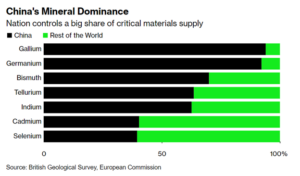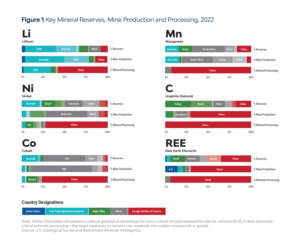The Inflation Reduction Act, signed into law by President Biden on August 16, 2022, was the most significant signal of support for the transition to electric vehicles by the federal government. It serves as a critical part of the effort to achieve the Biden Administration’s goal that 50 percent of all new vehicles sold in 2030 are electric—an essential step toward reducing the United States’ dependence on oil.
It also lays the foundation for building secure supply chains for electric vehicles, from the nations where critical minerals are mined and processed to those where parts are manufactured and vehicles are assembled, because it is important that we adopt EVs not only to enhance our national security and address climate change, but also that we and our trading partners maintain strategic control over EV supply chains, and capture the economic benefits that accrue from hosting such an economically significant manufacturing sector.
While the IRA addressed nearly the entire span of the energy and environmental landscape it included several provisions to support electric vehicles.
- EV Tax Credit: The IRA expanded the EV tax credit, removed limits on the number of vehicles eligible from each manufacturer, included used vehicles, supported monetization of the credit at the point of sale, and established a cap on Manufacturer’s Suggested Retail Price (MSRP). It also incentivizes processing of battery minerals in the United States and in countries that are our trading partners, as well as final vehicle assembly in North America.
- EV Charging Infrastructure: The IRA extended the residential credit to 30 percent of the cost of hardware and installation, up to $1,000. It also expanded the commercial credit to 6 percent, up to $100,000 per unit for infrastructure in rural and low-income communities. This supplements the $7.5 billion allocated for charging networks by the Bipartisan Infrastructure Law.
- Tax Credit for Critical Mineral Manufacturing: The IRA established a tax credit for the domestic processing of critical minerals, including lithium, cobalt, nickel, graphite, and manganese, all critical in the manufacturing of EV batteries.
Together, these provisions touched nearly every aspect of EV manufacture, sale, and use, as part of a coordinated effort to electrify the vehicles Americans drive.
The tax credits will make a full lineup of EVs available to drivers with a range of incomes, while limiting use of the credit for the most expensive vehicles, typically bought by the most affluent customers, to ensure that the limited funds available are focused on the households where they will make the most difference.
Funding charging infrastructure will help ensure that all drivers have access to the critical charging infrastructure without which these cars cannot operate.
Finally, the tax credit for manufacturing and the mineral and manufacturing requirements in the vehicle credit will promote the development of secure North American and Trading Partners’ supply chains, responding to China’s head start and limiting Beijing’s ability to exercise geopolitical and economic leverage by monopolizing this increasingly vital sector and its supply chain.
Key Decisions Remain
To help implement the tax credits in the IRA, the Department of the Treasury has developed guidance for taxpayers. In the fall of 2022, Treasury sought comment on a range of issues related to the Section 30D vehicle tax credit. It is in the midst of a rulemaking process that will detail the operation of the tax credit. Treasury has not yet addressed the limits of relationships between auto manufacturers and their suppliers, as well as the relationships between China’s government and Chinese firms, while maintaining eligibility for their vehicles to obtain tax credits.
These Foreign Entity of Concern provisions will be critical to the development of secure supply chains.
These Foreign Entity of Concern provisions will be critical to the development of secure supply chains. This process will inevitably be complex and the subject of intense lobbying by stakeholders across the supply chain. Treasury also has also issued guidance regarding implementation of the Section 30C tax credit for EV charging infrastructure, and the Section 45X tax credit, the production tax credit for critical minerals.
A Measurable Impact
The EV provisions of the IRA are clearly having an effect. Both industry and our foreign trading partners are paying close attention to the benefits and have mobilized to ensure that they can access them. In March of this year, Japan and the United States signed a critical minerals agreement that committed both nations to work together to responsibly produce critical minerals for EV batteries and to maintain a practice of not taxing the export of covered critical minerals, making minerals processed in Japan eligible for favorable treatment with respect to the vehicle tax credit. The United States is in the process of negotiating similar agreements with the European Union and the United Kingdom. Other nations are seeking similar agreements.
Perhaps one of the best indications the law is working as intended is that. Last fall the Chinese ambassador to the United States, seeking to highlight the “intertwined” interests of the United States and Chinese economies, stated that “to decouple with China means to disconnect from the world’s largest market as well as the biggest opportunity,” pointing out that General Motors Co.’s latest models are “designed, developed, produced and to be sold” in China, while more Chinese cars are being exported to the rest of the world.
Chinese companies are entering into business arrangements that are intended to skirt the law and allow their participation in the manufacture of vehicles that are eligible for the tax credit
At the same time, Chinese companies are entering into business arrangements that are intended to skirt the law and allow their participation in the manufacture of vehicles that are eligible for the tax credit, including partnerships with Ford and CATL and numerous investments by Chinese companies in Korean companies who benefit from South Korea’s free trade agreement with the United States.
Auto manufacturers and their suppliers have responded to the incentives in the IRA. At least 23 companies have announced over $40 billion in investments in at least 27 separate investments in at least 12 states and one Canadian province in battery cell, cell components, and battery module manufacturing.
Further, at least 13 companies have announced investments greater than $8 billion, in at least seven states in EV parts manufacturing and vehicle assembly. And at least seven companies have announced at least $4.5 billion, in at least five states, in investments in minerals processing and battery recycling for the recovery of minerals. This represents a strong foundation of a secure battery supply chain that the IRA sought to promote.
EV sales in the Q2 2023 increased by nearly 50 percent over the same quarter in 2022
The tax credit is having an effect on the U.S. consumer market for electric vehicles. For example, sales of the most popular EVs, the Tesla Models 3 and Y and the Chevy Bolt, which are once again eligible for the tax credit as the reformed credit no longer has a cap on the number of eligible vehicles from each manufacturer, represented over 60 percent of all EV sales during the first half of 2023.
The nearly 300,000 new electric vehicles sold in the second quarter of 2023 was an increase of nearly 50 percent over the same quarter in 2022. At the start of 2024 and 2025, the mineral sourcing and assembly requirements will initially reduce the number of EV models eligible for the tax credit. But as the investments in battery manufacturing in North America and mineral processing in our trading partner nations come online and are integrated into the EV supply chain, the number of vehicles eligible for the tax credit will grow and consumers will have greater choice. At the same, charging infrastructure will expand and include standardized provisions from the National Electric Vehicle Infrastructure Formula Program, improving the driver experience.
On The Verge of Significant Change
The future of EVs appear to be at an inflection point. There are more electric vehicles on the market than ever before, and manufacturers are making significant commitments to electrification, including shifting exclusively to EVs in some cases. And sales are up, with EVs constituting 7.2 percent of all auto sales in the second quarter of 2023.
Still, EV sales remain a relatively small part of overall vehicle sales. And the success of the Section 30D tax credit of the purchase of a new EV may be dependent on how the guidelines that the Department of the Treasury issues regarding the extent to which China and Chinese firms may participate in the supply chain for vehicles eligible for the credit.
Finally, while many early adopters have access to home charging, the industry has to find better charging solutions as they expand EV sales to customers who may have less access to at home charging. Likewise, charging EV during intercity travel remains more logistically difficult and time consuming than for gasoline cars, and this may affect EVs’ market penetration over time.
Tackling The Challenges Ahead
Despite the success that IRA has generated so far, and the prospects that it will continue to over time, very real risks remain. We can see China working to exert leverage over its trading partners in response to trade practices that seek to constrain China.
Over $50 billion of EV related investments in the United States alone have been announced this past year
In July, China announced limits on the export of germanium and gallium, two metals that are key to manufacturing electronics and semiconductors. This demonstration of China’s willingness to respond to aggressive trade policy is reminiscent of its 2010 ban on exports of rare earth elements to Japan following a dispute over the alleged incursion of a Japanese fishing vessel into Chinese water.
The electric vehicle provisions of the IRA are designed to accelerate the transition of the United States’ light duty fleet from one powered by oil to one powered by electricity. At the same time, they are designed to promote the development of a secure supply chain that will promote economic security and minimize the risk that China can dominate the EV sector in the future and use its economic position to exercise geopolitical leverage.
So far, the tax credits appear to be having their intended effect. EV sales are growing and over $50 billion of EV related investments in the United States alone have been announced this past year. While success is not guaranteed, and the issuance of guidelines regarding the extent to which China and Chinese companies can participate in the supply chain for tax credit eligible vehicles will play a critical role in the development of EV supply chains, the implementation of the EV policies is a success so far.
We are confident that if the government continues implementing the law in a manner consistent with the goals summarized above, the IRA will ultimately demonstrate how thoughtful government policy can support American industry, enhance economic security, respond to the climate crisis, and give American consumers a better product to help enhance their daily lives.








